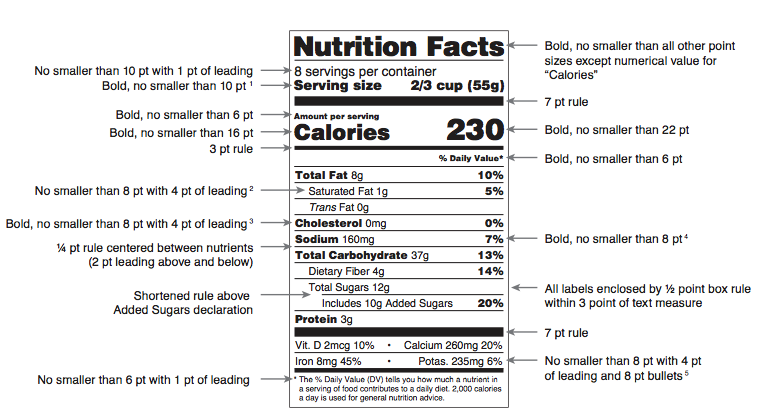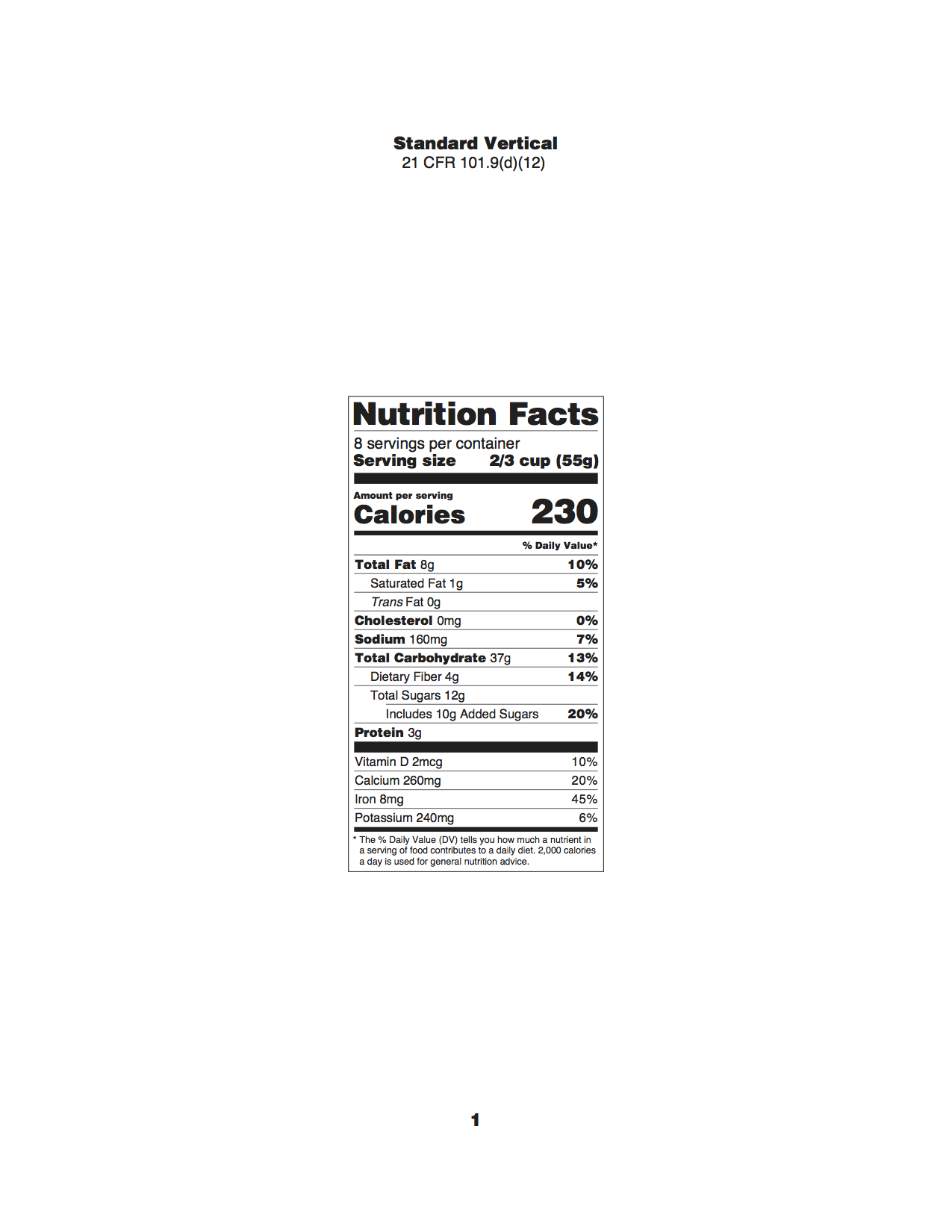The Scoop: There are very specific requirements for expressing nutrition information on food packaging. Use an online label generator.
What You Need to Know
The FDA regulates nutritional information panels, their formats, and requirements.
Nearly all packaged products require nutrition information although exemptions do exist
You can calculate the nutrition contents of a food using an online nutrition calculator or via a lab analysis of a food sample.
The requirements for nutrition labels may vary depending on:
Food package size
Claims made about the product, its ingredients, and health benefits
New Rule on Nutrition Information Panels
Key Changes in Nutrition Information
In 2016, the FDA updated the requirements for nutrition information panels on foods. The changes include
Changing the "Serving Size" to reflect how much someone customarily eats, not how much someone should eat
Calories are now in larger and bolder type
"Added Sugars" are now required to be included on the label
Listings of Vitamin D and Potassium are required
Actual amounts must be present for Vitamin D, Calcium, Iron, Postassium,
Removal of the "Calories from fat" label requirement
Removal of the requirement for Vitamin C and Vitamin A
When Do New Labeling Requirements Take Effect?
Businesses with >$10 million in Annual Food Sales: January 1st 2020
Businesses with <$10 million in Annual Food Sales: January 1st, 2021.
Components of a Nutrition Information Label:
Serving Size
The serving size must closely equate to the amount that is customarily eaten. This must be expressed in common household measures (i.e. cups, oz, tsp) and include the equivalent metric quantity in parentheses.
Nutrient Components:
The nutrition information label must include some mandatory components (i.e. calories, fat) and may include other voluntary components (vitamin A). No other declarations of nutrition information is allowed on the label, other than those listed below:
Mandatory Nutrient Components
Calories
"Fat" or "Total Fat"
Saturated Fat
Trans Fat
"Cholesterol"
"Sodium"
"Total Carbohydrate"
"Dietary Fiber"
"Total Sugars"
"Added Sugars"
"Protein
Voluntary Nutrient Components
"Calories from saturated fat"
"Fluoride"
"Soluble Fiber"
"Insoluble Fiber"
"Sugar Alcohol"
There are specific requirements for how these nutritional elements be described, particularly when there is a small amount of them. This information can be found in 101.9 (c)
Vitamins, Minerals and Macronutrients
The following vitamins and minerals are required on the nutritional label "Supplemental Facts" section. They must be measured in terms of percentage of daily value and weight.
The minimum requirement is listed below (must be listed in this order):
Vitamin D,
Calcium
Iron
Potassium
When additional vitamins and minerals are listed, the following order should be preserved:
Vitamins (listed in order)
Vitamin A
Vitamin C
Vitamin D
Vitamin E
Vitamin K
Thiamin
Riboflavin
Niacin
Vitamin B6
Folate
Vitamin B12
Biotin
Pantothenic Acid
Choline
Macronutrients & Minerals (In order)
Calcium
Iron
Phosphorus
Iodine
Magnesium
Zinc
Selenium
Copper
Manganese
Chromium
Molybdenum
Chloride
Potassium
Vitamins and minerals must appear in the label if:
They appear in a serving of the product
When they are added as a nutrient supplement
When a claim is made about them
However, non-required vitamins and minerals may be excluded if:
Neither the nutrient nor component are referred to on the label or advertising of the product
If they appear in the product solely for technological purposes
Note that other vitamins and minerals may be required or permitted on the label of standardized foods (i.e. foods that have a specific definition under the FDA Standards of Identity).S
How to Make an FDA Compliant Nutrition Information Label
FDA Aligned Nutritional Label (New Rule)
Have a final product: It is important that you are producing your product consistently and with the same ingredients so that the nutritional label you generate is accurate.
Determine the nutritional contents of your product: You can do this in one of several ways:
Conduct your own nutritional analysis using an online nutrition calculator. Google it or try Spark Recipes (This may not be the best one, it's the first one I found)
Have your product tested by a laboratory (EMSL is a nationwide provider that can do nutritional analysis)
Note: If the FDA tests your product due to a complaint or concern, they will conduct a nutritional analysis on 12 samples from 12 different cases.
Build a nutritional panel and align with the formatting guidelines:
The lab or online calculator may generate one for you automatically. If so, confirm it is aligned with the new nutritional facts rule (the easy way to tell is that the "calories" section is in a larger font). It should align with all of the standards listed above.
If you'd like to design your own, consider the image below for guidance.
Update your nutritional panel every time you make a change to the recipe or the ingredients: Additionally, you may have to change the nutritional panel if you decide to make a health claim in your advertising or on the product label.
Looking for Something Else?
Information about labeling "variety packs" and separately packaged foods sold in one box is available in section 101.9 (11) (h)
























